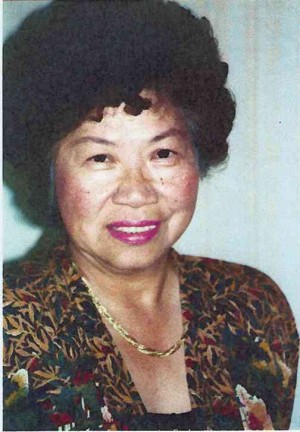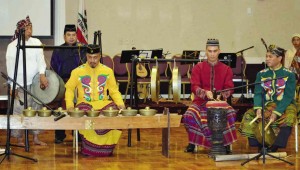A taste of home in San Diego
SAN DIEGO, California—The bamboo poles are laid out criss-crossed on the floor as agile performers hit these against the ground in rhythmic fashion.
Garbed in a colorful native dress indicating Muslim royalty, a dancer weaves through the fast-moving poles with ease, swaying to the beat of gongs and drums. Behind her trails a lady-in-waiting, holding aloft an umbrella adorned with jewels and sequins.
This is the singkil, a dance made famous by the Maranao people of Southern Philippines, and it was performed not at the Cultural Center of the Philippines nor at a tribal gathering in Mindanao, but at a packed convention center in Southern California.
It was one of the dances showcased by the Samahan Filipino-American Performing Arts and Education Center when it celebrated its 40th anniversary at the Scottish Rite Event Center in San Diego recently.
Founded in 1974 by the late Lolita Diñoso Carter, Samahan holds Filipino folk dance and music classes for those interested in knowing more about their roots through the arts, and performs in concerts and other community events.
The center highlights dances from all over the Philippines. The indigenous dances of the Mountain Province, the tribal dances of Mindanao and rural farm dances, such as tinikling, are all painstakingly recreated by trained dancers and musicians based in Southern California.
Samahan has performed all over the United States, participating in the Northwest Folklife Festival in Seattle, Washington, and the Los Angeles Festival of Philippine Arts and Culture, among others.
Carter, a dance instructor at Grossmont College in El Cajon, California, drew inspiration from her experiences growing up in a small town in the Philippines and her classes under Francisca Reyes Aquino, a pioneer of Philippine Folk Dance.
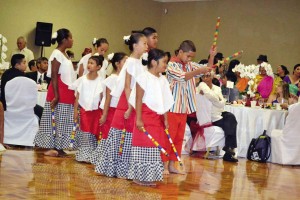
THE 40TH anniversary of Samahan proves that no matter where they are, Filipinos love to celebrate—and share—their roots and traditions.
Over the years, dancers and musicians from all over the state have helped Samahan grow into the much-loved institution it is today.
Ruby Pearl Chiong joined the group in 1975 as a dancer, teacher and choreographer. She brought with her from the Philippines a hefty portfolio culled from performances with the Far Eastern University Dance Troupe and knowledge of dance from the mountain provinces of northern Luzon and southern Philippines.
In 1980, University of the Philippines professor and ethnomusicologist Bayani Mendoza de Leon helped set up Samahan’s Rondalla, Gangsa and Kulintang Musical Ensembles.
Cotobato-born kulintang artist Danongan Sibay Kalanduyan became a guest teacher at the company for several years. And, in 1991, George Ragaza joined the group as artistic director, premiering several new dances such as the kaamulan, a Manobo rite of sharing.
Samahan officially obtained status as a nonprofit, public benefit corporation in 1978.
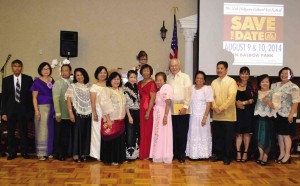
SHARING ROOTS, TRADITIONS The Samahan Filipino-American Performing Arts and Education Center pose for a souvenir shot during its 40th anniversary at the Scottish Rite Event Center in San Diego recently.
Encouraged by the enthusiastic support of compatriots in the community, Samahan launched the Philippine Folk Festival in 1979, enjoying wide patronage for six years. It was revived in 1996 as the Philippine Cultural Arts Festival. The celebration is a significant event for the Filipino community in San Diego and its neighboring counties as an outstanding showcase of Filipino culture.
This doesn’t come cheap, however.
“Fundraising. That’s the No. 1 challenge,” says Dina Ellorin, a retired environmental health specialist and president of Samahan, who claims the dancers almost always get a standing ovation each time they perform. To get subsidies for their costumes, stage paraphernalia, publicity or rent for the venue, the center relies on the financial backing of supporters and grants from the US government. Ellorin, in fact, calls the recent anniversary a fundraising success, primarily due to the undying enthusiasm and dedication of its fans.
The 40th anniversary celebration featured performances from current members and alumni, who, with a tinge of nostalgia, gamely slipped into their old costumes one more time.
Carmelita Lopez, a psychiatrist and long-time supporter from El Cajon, says she keeps coming back to watch each and every performance for the “beautiful dancing, lively music and colorful costumes.”
A few of the dances they performed included the Spanish-influenced “Aray,” with the men dressed in elegant barong Tagalog and the women clad in exquisite Maria Clara-style dresses, and the sakuting, performed with a stick in each hand.
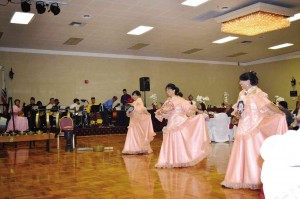
FEELING THE MUSIC To get subsidies for their costumes, stage paraphernalia, publicity or rent for the venue, the center relies on the financial backing of supporters and grants from the US government.
The music was provided by the Samahan rondalla and the Pakaraguian Kulintang Ensemble. Juanita Caccam and her students also played the angklung, a bamboo instrument popular throughout Southeast Asia.
Nichi Aviña, a former Samahan dancer who had a year-long stint with the Bayanihan troupe when it went on a tour of Europe, says that getting up on stage was personally rewarding. “I really enjoyed performing, the whole aspect of preparing for each show. I loved the dances. ”
Now a middle-school science teacher in the resort city of Palm Desert, a two-hour drive from San Diego, Aviña describes the experience as “like a memory that’s deeply ingrained in my bones. It was a calling. I really felt the music. I really felt the moment.”
For Filipinos far from home, music and dance can be a powerful way of keeping in touch with the country they left behind. And for new generations born in the United States who have never been to the homeland, it’s a way of connecting with their culture.
Kulintang Ensemble director Bernard Ellorin says Samahan instilled in him “pride in my Filipino heritage and awareness of being Filipino-American. More importantly, it exposed me to different artists and different kinds of performance venues, apart from enhancing my creativity through music.”
Samahan, too, serves as a haven of good vibes for young people. The after-school programs and free workshops that the center provides help lead kids away from street gangs, drugs and other potentially harmful influences. In fact, the center has conducted a successful neighborhood arts program geared toward at-risk youth.
The 40th anniversary of Samahan proves that no matter where they are, Filipinos love to celebrate—and share—their roots and traditions.
Thousands of miles away from the Philippines, Samahan is a wistful and wonderful taste of home.
